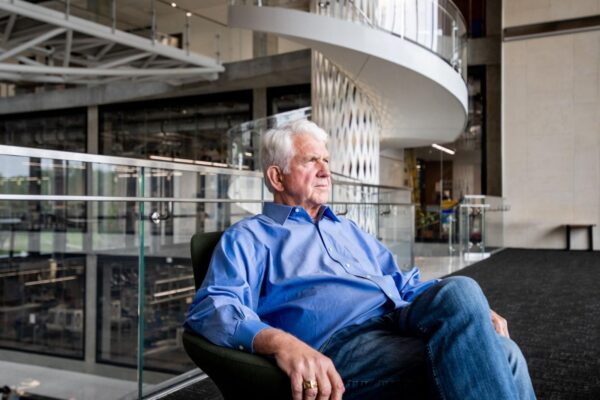AUSTIN, Texas — Bob Metcalfe, professor emeritus in the Chandra Family Department of Electrical and Computer Engineering at The University of Texas at Austin, was named the recipient of the 2022 Association for Computing Machinery (ACM) A.M. Turing Award for the invention, standardization and commercialization of Ethernet.
The ACM A.M. Turing Award, often called the “Nobel Prize of computing,” includes a $1 million prize, with financial support provided by Google. The award is named for Alan M. Turing, the British mathematician who articulated the mathematical foundations of computing.
“It is dangerous to accept an award for developing Ethernet, which turns 50 on May 22, 2023,” Metcalfe said. “Over Ethernet’s 50 years, hundreds of people have earned some claim of inventorship. Join me in saying to these folks, ‘Thank you.’”
Before retiring from UT Austin in 2021, Metcalfe led innovation initiatives in the Cockrell School of Engineering and across campus for a decade. He is the founding director of the Texas Innovation Center, which launched in 2011 to help faculty members and students bring their scientific and engineering discoveries to market. He envisioned helping Austin become a better version of Silicon Valley.
“Bob has made several important contributions to the tech industry. His invention of Ethernet revolutionized how everyone interacts with computers and each other,” said Roger Bonnecaze, dean of the Cockrell School of Engineering. “This prestigious award is very well-deserved indeed!”
During his time at UT, Metcalfe was a fixture as a speaker and adviser for entrepreneurial groups and events across campus. He was a major part of Longhorn Startup, a fall course that gives students an opportunity to hear from entrepreneurs and then pitch their own projects. And he created a startup studio and salons within the Cockrell School to help professors and students sharpen their startup ideas.
In 1973, while a computer scientist at the Xerox Palo Alto Research Center (PARC), Metcalfe circulated a now-famous memo describing a “broadcast communication network” for connecting some of the first personal computers, PARC’s Altos, within a building. The first Ethernet ran at 2.94 megabits per second, which was about 10,000 times as fast as the terminal networks it would replace.
Although Metcalfe’s original design proposed implementing this network over coaxial cable, the memo envisioned “communication over an ether,” making the design adaptable to future innovations in media technology including legacy telephone twisted pair, optical fiber, radio (Wi-Fi), and even power networks, to replace the coaxial cable as the “ether.” That memo laid the groundwork for what we now know today as Ethernet.
Metcalfe’s Ethernet design incorporated insights from his experience with ALOHAnet, a pioneering computer networking system developed at the University of Hawaii. Metcalfe recruited David Boggs, a co-inventor of Ethernet, to help build a 100-node PARC Ethernet. That first Ethernet was then replicated within Xerox to proliferate a corporate internet.
In their seminal 1976 Communications of the ACM article, “Ethernet: Distributed Packet Switching for Local Computer Networks,” Metcalfe and Boggs described the design of Ethernet. Metcalfe then led a team that developed the 10 Mbps Ethernet to form the basis of subsequent standards.
“Ethernet was the plumbing upgrade the internet needed in the 1970s,” Metcalfe said. “Ethernet enabled the transition from Arpanet, a network of time-shared computers servicing dumb terminals, to an internetwork of personal computers, their servers, and routers.”
Today, Ethernet is the main conduit of wired network communications around the world, handling data rates from 10 Mbps to 400 Gbps, with 800 Gbps and 1.6 Tbps technologies emerging. Ethernet has also become an enormous market, with revenue from Ethernet switches alone exceeding $30 billion in 2021, according to the International Data Corporation. Learn more about Metcalfe and his work on Ethernet.




